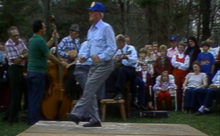Talking Feet, Names of Steps and Origins
In premedia traditional culture, individual styles of speech, singing, music-making and dancing were highly valued. To some extent, I believe this individuality is also apparent when traditional dancers talk about dance, in their nomenclature. In other words, since there is no standard dictionary of terms, traditional musicians and dancers devise their own individual terms. So just as there are some similarities and individualities in style, there are some in nomenclature. Most dancers will agree that "flatfoot" is just a group of steps closer to the ground than "buck," but some will say that "buck" consists of certain steps done only up on the toes. And some, like Hicks and Reece, will say that the flatfoot dance is just one step, not a group of similar low-to-the-ground steps (or motions, moves) that others might call flatfoot style. For the present, I think we must accept each person's names for their steps and style just as we accept their dance. For instance, we may need to use a term such as "John D. Holeman's buckdance" or "John Reeves' buckdance" to describe those two very different styles that use the same name. And for convenience of communication in the future, we will probably want to develop a useable standard nomenclature. I am reluctant to do that here, and will say that it is beyond the scope of this project.
About the Term "Clog"
The word "clog," which is used widely by the general public to describe any kind of foot dancing to Southern string music, was not used by any of our older traditional dancers to describe their style. This term has been used occasionally in western North Carolina since about 1930, primarily to describe dances done by teams in competition or performance. Most of our dancers said that they first heard the term after about 1970.
Clog dancing is a modern blend based on the older flatfoot, buck and hoedown styles just as modern country music is an evolution and amalgam of older forms. It can include almost any move or step, ranging from a simple "basic" used by teams, to the very complex and difficult steps used by some soloists. In most team dancing, broad, showy moves have evolved to communicate well on stage or TV. Team cloggers often use simple, basic steps, while performing routines partially based on traditional square dance figures. Some teams perform "free style," that is, each dancer is free to do their own type of steps during the course of a dance. Others perform "precision" clogging, in which dancers do choreographed steps in unison, and sometimes use a single step throughout a dance. As far as we can tell, precision clogging got its start when a northern choreographer worked with James Kesterson's Blue Ridge Mountain Dancers in western North Carolina, in the early 1960s.
Speculation on Origins
There has been virtually no visual documentation, and very little written description, of traditional Southern solo stepdancing, so that any "history" of its origins and development will have to consist largely of continuing, interesting conjecture. I hesitate to add to the existing folklore about the origins of solo Southern foot dance but will make a few basic observations.
I believe that to get some idea of the process of Southern vernacular dance development, we must consider it in parallel with its companion music and the dominant cultures that have mixed to produce it: British, African, and to some extent, Native American. These cultures began their intense musical interaction here in the 17th century, first among African-Americans and then in the 19th century among British-Americans, especially in small Southern towns and nearby rural areas. A good example of Anglo/Afro interaction in music is the introduction of the banjo, originally an African instrument. It is quite certain that the interaction between the European fiddle and African banjo changed the styles and repertoire of both. African-Americans first played these instruments together soon after being brought here, and the banjo/fiddle combination was the basis for the late 19th-century/early 20th-century mountain music to which most of our older dancers moved.
The creation of this new body of music simply had to influence the evolution of its vital companion, dance. But rather than make any generalizations about what came from where after such a long period of development devoid of sufficient documentation, I believe that it is best, at least for this project, to report and understand what we can verify now. In the future, we should give this field the same attention as that presently given to vernacular music, visual art, folklore, social interaction and so forth.
